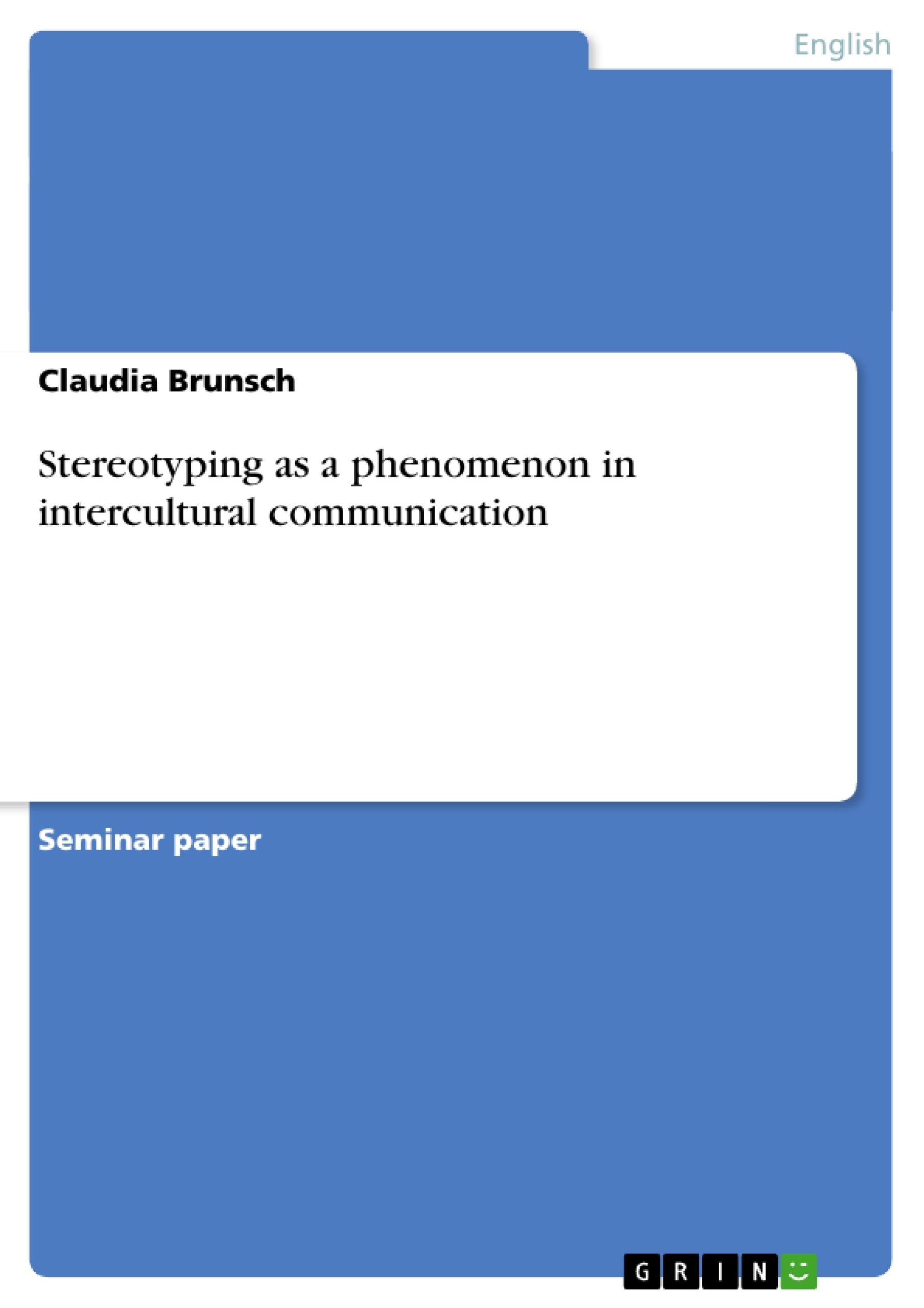Extracto
Table of Contents
I. Introduction
II. Intercultural Communication
1. Communication
2. Culture
III. Definition of Stereotype
IV. Autostereotype and heterostereotype
V. How do hetereostereotypes and autostereotypes occur?
1. The process of heterostereotyping
VI. Normative and personal stereotypes
VII. Mindless and mindful stereotyping
2. Mindful stereotyping
VIII. Positive and negative stereotyping
1. Negative Stereotyping
2. Positive Stereotyping
IX. Stereotyping and its effects on communication
1. Stereotyping as a positive process
2. Stereotyping as a negative process
X. Summary
I. Introduction
Intercultural communication has become more and more important in a world where everything is becoming global. Few centuries ago only international managers or diplomats had to think about intercultural communication and its problems.
These days not exclusively international managers but “ordinary” people from different cultures come into contact with each other. This phenomenon can be explained due to various reasons. The internet makes it possible to communicate with people from all over the word, modern technologies give people the chance to travel further and faster than ever before. Not only big firms, but also all kinds of organizations act more and more global instead of local. The European Union allows people to move to other European countries, to work and to live there.
We live in a multicultural society with various cultures. Intercultural communication has become a theme which concerns everybody and which will even become more and more important in our world of globalization where people from all over the world come together and get in contact with each other.
The topic of my paper is “Stereotyping as a Phenomenon in Intercultural Communication”.
As a basis I will describe the term “intercultural communication” by explaining the model of communication and by trying to give a definition of “culture”. I will focus on the topic of stereotypes by giving a definition and by showing different forms of stereotypes and explaining the difference between positive and negative stereotyping. Furthermore, I will explain how stereotyping arises and how it can have a positive as well as a negative effect on intercultural communication.
II. Intercultural Communication
Intercultural communication deals with the question how people with a different cultural background can understand each other.[1]
Intercultural communication, also often called cross-cultural communication or trans-cultural communication can be defined as an “exchange process between persons of different cultures”.[2] The basis is the concept of communication.
To understand the term of intercultural communication it is necessary first to understand what communication is, what it concludes and how it works.
1. Communication
Communication is an exchange of meaning caused by a sender who sends a message to a person who receives the message, the receiver. In this process the sender encodes the message, which means that he produces a symbol message and the receiver has to decode the message, which means that he must try to understand the meaning of the symbol. The received message can be very different from the message which was sent. In other words: sent and received messages are never identical. This can be explained because of the fact that communication is a complex process. It does not only include verbal but also nonverbal messages. Verbal messages are the words, sentences and phrases which are spoken; nonverbal messages are gestures, mimic or the tone of voice.
Communication also contains consciously send messages as well as unconsciously send messages. Even if he does not want to, the sender sends messages he is totally unaware of. It can be seen that communication has many sources of misinterpretation which rise with the differences in cultural background. The greater the differences in cultural background between sender and receiver, the greater the differences in meaning connected to special words and behaviors.[3]
2. Culture
Intercultural communication can be defined as communication between people from different cultures. But what is culture? How can it be defined?
There is no standard definition of the word “culture”. According to one definition culture can be understood as the “shared assumptions, values and beliefs of a group of people which result in characteristic behaviors”.[4] Hofstede calls this a “collective mental program” or “software of the mind”.[5] The definition includes two dimensions: an invisible dimension (assumptions, values and beliefs) and a visible dimension (behavior). These two dimensions are connected in a cause-and-effect relationship which means that they influence each other.[6]
A more narrow national opinion defines culture in the sense of arts, literature, geography and history.[7] Culture in this sense means national culture.
The first definition however might be more meaningful because attitudes, values and beliefs are more significant than national aspects in binding people together.
To conclude, it can be said that it is not easy to define culture. However, it has become obvious that the term culture is more than the distinction between different nations.
[...]
[1] Bennett, Milton J.: “Basic Concepts of Intercultural Communication” (1898), 1
[2] Ting-Toomey, Stella: “Communicating Across Cultures” (1999), 21
[3] Adler, Nancy: “Communicating Across Cultural Barriers“ in: Bolten, J./ Erhhard, K.: „Interkulturelle
Kommunikation. Texte und Übungen zum interkulturellen Handeln“ (2003), 247 f.
[4] Storti, Craig: “Figuring Foreigners Out – A Practical Guide“ (1999), 5
[5] Gibson, Robert: “Intercultural Business Communication“ (2000), 16
[6] Storti, Craig: “Figuring Foreigners Out – A Practical Guide“ (1999), 6
[7] Ned Seelye H.: “Teaching Culture- Strategies for Intercultural Communication” (1993),14; Gibson,
Robert: “Intercultural Business Communication“ (2000), 16
- Citar trabajo
- Claudia Brunsch (Autor), 2005, Stereotyping as a phenomenon in intercultural communication, Múnich, GRIN Verlag, https://www.grin.com/document/69989
Así es como funciona






















Comentarios